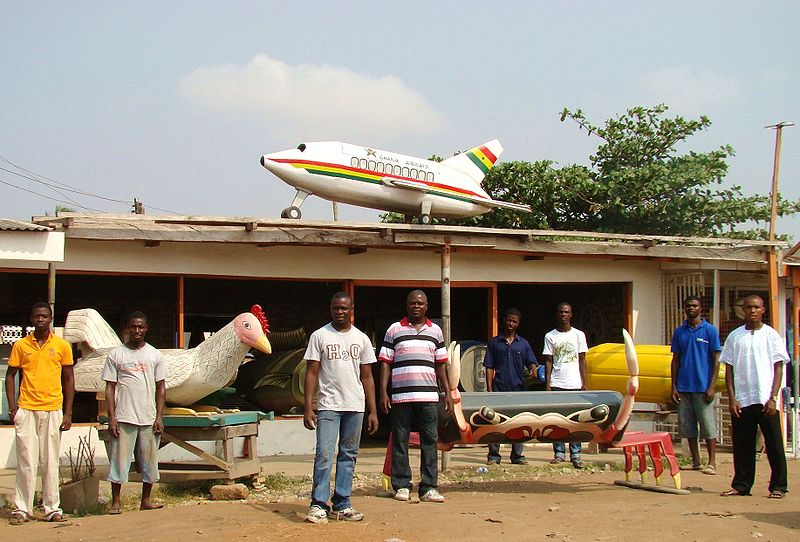
If you are an early follower of Digital Dying and tuned in your radio dials to just the right station last week, you would have heard words about an old friend.
“In Ghana, coffin makers have elevated death into an art form,” rang the airwaves of NPR’s show, The World.
The topic was none other than fantasy coffins, which are coffins crafted by expert woodworkers in the west African country of Ghana and designed to resemble an object or item from a person’s life, or one they have longed after but never been able to achieve. We have written about fantasy coffins a number of times. The first article was in 2009, our very second Digital Dying post, entitled “Bury Me In A Uterus, Or A Ferrari.”
In that article, we mentioned an African website that sells fantasy coffins called eShopAfrica.com. “Keep your line to heaven open – go to the afterlife in a Nokia,” reads a post from one of the items sold on the site. “The face of the phone opens to make the lid. Whatever brand you want, our carpenters can make it for you – even blue tooth!”
Not only is eShopAfrica.com still around and still selling fantasy coffins, but the Nokia phone fantasy coffin is still available. In fact, many of the fantasy coffin shapes we first wrote about back in 2009 appear to still be available: a carrot, a pineapple, okra, a pile of cloth, a machine gun barrel, a handsaw, a carpenter’s vice, a gas truck, a beer bottle, and a cigarette.
The site is also now making what they describe as thematic chests. Traditionally these would be the size of a full coffin or a half-length coffin, but the site is presently “working with the coffin carpenters to scale down their work making it easier to ship.” This seems like a sure sign that the trend in fantasy coffins has moved far beyond the borders of Ghana, as the woodworkers strive to ship their wares to customers overseas. They are also developing new lines, such as football and computer mouse. “The coffin carpenters,” says the website, “can make just about anything you want.”
As is the case with the original idea behind the fantasy coffins, many of the coffin themes still do resemble actual objects of fancy and fantasy. “Have you dreamed of owning a Ferrari?” the site wonders. “Dream no longer… buy your own handmade African Ferrari today! Just look at the detail… And it opens into a chest to keep things in! A truly unique work of art!” To keep with the times, I suppose Subaru fantasy coffins are now available too.
But as our original article noted, not all Ghanaians agree with fantasy coffins. It seems the trend had gotten so popular that some folks turned against it. One reason was the belief that fantasy coffins were just a lavish waste of money. “Children of the dead must not be compelled to do things which their resources cannot meet,” one pastor stated, a leader in the Church of Pentecost in Ghana. “How can the people of a nation, which is fighting to reduce poverty, continue to dissipate valuable resources on funerals,” the preacher asked.
Another critique came from a Ghanaian newspaper columnist, who in 2007 exclaimed, “The dimension which contemporary Ghanaian funerals have assumed over the last decade gives a great cause for concern if not worry.” They added, “Consciously or unconsciously, we seem to measure the efficiency of a minister or Member of Parliament by the number of funerals he attends every weekend!” The point here seems to be that funerals should not be made to represent a societal status marker.
In our second blog that mentioned fantasy coffins, published in October 2010 and entitled, “How to be buried in a hot rod and sing at your own funeral,” we actually discussed a sort of American version of the concept.
“The Los Angeles-based coffin company has developed a car-shaped coffin complete with side-view mirrors, headlights, bumpers, and whitewall tires with chrome rims. Unlatch the top, just as a regular coffin is opened, and there is space for a body. Presently, the company is only manufacturing 1950s style Mercury’s, but they can customize other styles. Before you fill the coffin with a body, the company suggests, you can store other things in it, like beer. The cruising casket website features a man in dark shades and a shirt with flames kneeling beside a metallic blue Cruisin Casket that is filled with Heineken mini-kegs. “One cool thing about this casket is when you preneed it, the family can take it home and use it for other things until it is needed at the time of death,” reads a funeral directors’ website that reviewed the product. “For example, the casket could be used as a huge cooler if the family also purchased the replaceable liner kit.”
Later, in our January 2014 post, “Seven Death-themed Museums to Visit in 2014,” we mentioned the National Museum of Funeral History in Houston, Texas.
There are hearses from the 1920s and 1930s, including a bullet-proof Range Rover hearse for the Pope that dates back to the early 1980s and an artful Japanese hearse. A coffin exhibit features coffins made of ice and glass and a replica of Abraham Lincoln’s casket, as well as coffins from cultures across the world, such as the decorative coffins of the Caribbean and the fantasy coffins of Ghana. “I was actually quite surprised at the detail and thought that has gone into this museum,” wrote one Yelp reviewer. The museum is open Monday to Fridays 10 am to 4 pm, Saturdays 10 am to 5 pm, and Sundays 12 pm to 5 pm.
We wrote about the National Museum of Funeral History again later that same year, with an article entitled, “National Museum of Funeral History Breathes Life Into Death.” This post provided more information on the museum’s interesting history and its ongoing exhibits and practices:
The story of the funeral museum begins with Robert L. Waltrip, a well-known figure in the funeral industry. The Waltrip family is best known for transforming a single funeral home located in Houston’s Heights community into the conglomerate Service Corporation International (SCI). Along the way, Mr. Waltrip dreamed of creating an institution that would preserve the history of the funeral industry and, at the same time, educate the public on the importance of the industry in our culture.
In 1992, Waltrip made this happen with the opening of the museum. Today the NMFH covers some 35,000 square feet of exhibit space and welcomes more than 1,500 visitors each month. New exhibits that reflect our changing funeral needs and customs are in the works, as are updates to displays that both honor our dead and help us think about our own funeral needs. Seasonal events are added throughout the year, such as the current Halloween-themed Dracula exhibit that is now in the rotation.
Throughout the museum, visitors will discover interesting trivia, such as the origin of the terms “dead ringer,” “saved by the bell,” “boneyard,” and “graveyard shift.”
The World radio program that ran last week on fantasy coffins was reported by Ridwan Karim Dini-Osman, an award-winning development journalist and news anchor based in Ghana.
Despite all the craziness of modern times, Dini-Osman’s article showed that many people still regard their favorite item and their preferred burial casket shape as a traditional object. Such as a simple wooden pen-shaped coffin designed for a deceased teacher or author. A palm fruit coffin is made for a deceased farmer, while another farmer is buried in a cocoa pod. A Bible coffin for a deceased Ghanaian pastor. A truck-shaped coffin is made for a trucker who has died, and a lion-shaped coffin for a chief, “because the cat is considered the ruler of the forest, a fitting match for a chief.”
Dini-Osman’s article discusses the fantasy coffin carpenter Lawrence Anang, 22, who views his job as both an honor and part of his family legacy. “Anang learned the trade from his father,” Dini-Osman writes, “who learned it from his family’s 60-year fantasy coffin-making business.”
One thing is certain, in an era when many hands-on traditions have been eclipsed by technology and faster and more electronically-driven lives, this tradition of wood and carpentry is still alive and well.
Although there is one other new item to note. According to The World radio piece, the latest trend in fantasy coffin funerals also involves” ‘dancing’ pallbearers dressed in flamboyant outfits to appear at funerals, who fancifully wobble to music as they carry coffins on their shoulders.”
This happens to be another topic Digital Dying has written about. You can check out our posts on “Inside the hot and noisy world of Taiwan’s Stripper Funerals” and “Stripper funerals in China, naked funeral directors in America.” And thanks for tuning in everyone~









